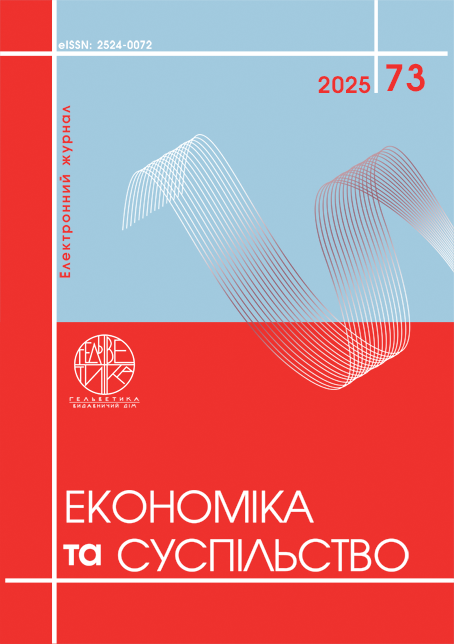DIGITAL TRANSFORMATION OF PERSONNEL MANAGEMENT: PROSPECTS AND CHALLENGES FOR BUSINESS STRUCTURES
Abstract
The article examines the digital transformation of human resources management as a critical factor in increasing the efficiency of business structures. Its main directions, their opportunities and challenges that companies face in modern conditions are considered. The impact of new technologies on key management functions, in particular on the processes of hiring, internal mobility, firing employees and workforce management, is analyzed. Particular attention is paid to the benefits of digital transformation, such as increasing productivity, optimizing HR processes, reducing the burden on management and improving the adaptability of companies in a competitive business environment. However, it emphasizes the existing difficulties, including the need for significant financial investments, cybersecurity risks, resistance to change among employees and a shortage of specialists. Also examined the influence of the martial law on the labor market and personnel management in Ukraine, and analysis of the main challenges faced by enterprises in the context of this crisis was carried out. The consequences of such critical problems for business as: staff turnover, structural inequality of personnel, limited opportunities for professional development, and high levels of psychological stress are described and analyzed. The results of the study confirm that digital transformation of HR is not just a technological trend, but a necessary condition for the adaptation of enterprises to modern market realities. It allows to increase the competitiveness of companies, to ensure their stability and resilience in periods of economic and social changes. For the successful implementation of digital HR tools, a strategic approach is required, which includes: investments in digital technologies (cloud platforms, analytical systems, automated HRM solutions), development of digital competencies among HR specialists and employees, integration of data analytics into the process of making management decisions. Thus, the digital transformation of human resources management opens up new opportunities for enterprises, allowing them not only to adapt to changes, but also to effectively use technology to develop human capital and optimize business processes.
References
Левицький, В. В., Радинський, С. В., Артеменко, Л. Б., & Радинська, С. (2024). Підприємництво України в умовах війни та цифровізації: можливості та перспективи удосконалення. In Трансформація бізнесу для сталого майбутнього: дослідження, цифровізація та інновації: монографія (pp. 235-253).
Кришталь, Г. О., Цімошинська, О. В., & Хіміч, С. В. (2024). Управління ефективністю цифрової трансформації підприємницьких структур: огляд наукових досліджень. Наукові праці Міжрегіональної Академії управління персоналом. Економічні науки, (4 (76)), 104-110.
Томах, В. В., Сігаєва, Т. Є., & Мартиненко, М. В. (2023). Цифрова трансформація управління підприємствами України у контексті сталого розвитку: інноваційні рішення, креативні технології. Академічні візії, (18)
Канцур, І., Меліневський, А., & Супруненко, С. (2023). Цифрова трансформація в управлінні бізнесом в умовах сучасних викликів. Via Economica, (3), 42-47.
Legner, C., Eymann, T., Hess, T., Matt, C., Böhmann, T., Drews, P., ... & Ahlemann, F. (2017). Digitalization: opportunity and challenge for the business and information systems engineering community. Business & information systems engineering, 59, 301-308.
Koster, Ferry, and Luc Benda. "Innovative human resource management: measurement, determinants and outcomes." International Journal of Innovation Science 12.3 (2020): 287-302.
Gërxhani, K., & Koster, F. (2015). Making the right move. Investigating employers’ recruitment strategies. Personnel Review, 44(5), 781-800.
Doherty, N. (1998). The role of outplacement in redundancy management. Personnel Review, 27(4), 343-353.
Tzafrir, S. S. (2005). The relationship between trust, HRM practices and firm performance. The International Journal of Human Resource Management, 16(9), 1600-1622.
Ng, I., & Dastmalchian, A. (2011). Perceived training benefits and training bundles: a Canadian study. The International Journal of Human Resource Management, 22(04), 829-842.
Levytskyi, V., Radynskyi, S., Artemenko, L., & Radynska, S. (2024). Pidpryiemnytstvo Ukrainy v umovakh viiny ta tsyfrovizatsii: mozhlyvosti ta perspektyvy udoskonalennia [Entrepreneurship of Ukraine in conditions of war and digitalization: possibilities and perspectives of improvement]. Transformatsiia biznesu dlia staloho maibutnoho: doslidzhennia, tsyfrovizatsiia ta innovatsii: monograph, 235-253
Kryshtal, H. O., Tsimoshynska, O. V., & Khimich, S. V. (2024). Upravlinnia efektyvnistiu tsyfrovoi transformatsii pidpryiemnytskykh struktur: ohliad naukovykh doslidzhen [Management of digital transformation effectiveness in entrepreneurial structures a review of scientific research]. Naukovi pratsi Mizhrehionalnoi Akademii upravlinnia personalom. Ekonomichni nauky, (4 (76)), 104-110.
Tomakh, V. V., Sihaieva, T. Ye., & Martynenko, M. V. (2023). Tsyfrova transformatsiia upravlinnia pidpryiemstvamy Ukrainy u konteksti staloho rozvytku: innovatsiini rishennia, kreatyvni tekhnolohii [Digital transformation of enterprise management in Ukraine in the context of sustainable development: innovative solutions, creative technologies]. Akademichni vizii, (18)
Kantsur, I., Melinevskyi, A., & Suprunenko, S. (2023). Tsyfrova transformatsiia v upravlinni biznesom v umovakh suchasnykh vyklykiv [Digital transformation in business management in the face of modern challenges]. Via Economica, (3), 42-47.
Legner, C., Eymann, T., Hess, T., Matt, C., Böhmann, T., Drews, P., ... & Ahlemann, F. (2017). Digitalization: opportunity and challenge for the business and information systems engineering community. Business & information systems engineering, 59, 301-308.
Koster, Ferry, and Luc Benda. "Innovative human resource management: measurement, determinants and outcomes." International Journal of Innovation Science 12.3 (2020): 287-302.
Gërxhani, K., & Koster, F. (2015). Making the right move. Investigating employers’ recruitment strategies. Personnel Review, 44(5), 781-800.
Doherty, N. (1998). The role of outplacement in redundancy management. Personnel Review, 27(4), 343-353.
Tzafrir, S. S. (2005). The relationship between trust, HRM practices and firm performance. The International Journal of Human Resource Management, 16(9), 1600-1622.
Ng, I., & Dastmalchian, A. (2011). Perceived training benefits and training bundles: a Canadian study. The International Journal of Human Resource Management, 22(04), 829-842.
Copyright (c) 2025 Тарас Воробець, Марко Мохнацький

This work is licensed under a Creative Commons Attribution 4.0 International License.


